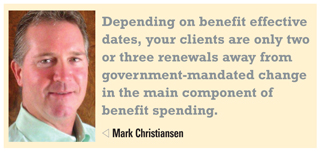Agencies focused on the day-to-day business of employee benefitsknow this legislation will hit hard and force change. A report released inJune by the business consulting firm McKinsey & Co. stated, "Theshift away from employer-provided health insurance will be vastlygreater than expected and will make sense for many companies andlower-income workers alike."
|McKinsey surveyed over 1,300 companies of all sizes and foundthat:
- Overall, 30 percent of employers will definitely or probablystop offering employer-based health insurance in the years after2014.
- Among employers with a high awareness of reform, thisproportion increases to more than 50 percent, and upward of 60percent will pursue some alternative to traditional employer-basedhealth programs.
- At least 30 percent of employers would gain economically fromdropping coverage even if they completely compensate employees forthe change through other benefit offerings or higher salaries.
- Contrary to what many employers assume, more than 85 percent ofemployees would remain at their jobs even if their employer stoppedoffering employer-based health insurance, although about 60 percentwould expect increased compensation.
The less talked-about factor of PPACA is just how fast thisforced change is coming. Depending on benefit effective dates, yourclients are only two or three renewals away fromgovernment-mandated change in the main component of benefitspending. With this level of forced change quickly approaching,conducting business-as-usual is a poor strategy for success. Ifyour thinking is, "My clients will stay with group medical becausethey want to have excellent benefits to keep and attract employeetalent," the last bullet point from the above-cited research shouldgive you pause. With the exchanges offering guaranteed issue healthplans—subsidized or not—employer-based major medical will fade inimportance. FindingOpportunity On the plus side, voluntary insurance options will rise inimportance. A full suite of group ancillary lines like dental,vision, disability, life, and even wellness plans can appeal toemployers and employees alike. Employers may be receptive tofunding or partially funding these enhanced benefits packages byusing the significant savings they realize when they pull theirdollars from health insurance.
On the plus side, voluntary insurance options will rise inimportance. A full suite of group ancillary lines like dental,vision, disability, life, and even wellness plans can appeal toemployers and employees alike. Employers may be receptive tofunding or partially funding these enhanced benefits packages byusing the significant savings they realize when they pull theirdollars from health insurance.
Assisting employees at the personal level with needs such aspermanent life, long-term care and annuities also will become abusiness-generating opportunity for agencies. For example: If youhave 20 groups with 25 employees each, that equals 500 individualselling opportunities. If you could write life, long-term care, orannuities on only 25 percent of them, you would have 125 newpolicies written, or more than 10 per month over the course of ayear.
|To help you analyze these opportunities, consider conducting anagency self analysis. If you are an employee benefits-based agency,refer to bullet points one and two from the McKinsey research andrun projections where your agency loses first 30 percent then 60percent of its current group health commissions. (It is not out ofthe question that five or six years down the road there will beemployee benefit agencies with little or zero group health on thebooks, particularly those agencies primarily working with groupsunder 500 employees.) Next, construct a functional model of howmany sales of other insurance lines it will take to replace thelost commissions from medical sales.
|Now write down all the categories of insurance and relatedservice lines that your top 20 clients have or may have. Include asmany as possible from both the life and health side and theproperty and casualty (P&C) side, and be specific. Include theemployee's personal insurance needs as well. Then put your namebeside every coverage your agency provides for each client.
|This exercise will give you a hard assessment of just how deeplyinvolved you are with every client. If you find only a couple ofinsurance products checked with your name, this might be a soberingmoment for your agency. It will show that your clients may begetting advice from other agents, consultants or advisors—peoplewho may be giving them conflicting advice and steering them awayfrom you. Innovation ThroughCollaboration
You should view this as an opportunity for innovation throughcollaboration. First, talk with your clients and conduct acomprehensive insurance evaluation of their needs and current andpossible coverages. Then proactively engage the other agents oradvisors dealing with your clients and discuss the opportunity forcollaboration. This can be done informally or—as I would suggest—inwriting, detailing the relationship, cross-competing arrangements,referral compensation, and anything else you agree is important.There are many ways to receive compensation for referrals withoutbreaking rebating laws or doing anything unethical. Take theagreement seriously, and create a strong document that is signed byboth parties and notarized. Develop trust in these relationshipsand you may find yourself working off of very warm referral leadson a regular basis.
While this innovative networking building arrangement may seemmost pressing for employee benefit-based agencies looking toenhance lost commission income, all agents or agencies can benefit.A qualified, trusted referral option enhances professionalism andoften leads to other opportunities to sell.
|Some multi-line agency managers think this collaboration alreadyexists within their agencies, with the P&C agents bringing inthe benefits agents and vice versa. While this is often intended,it is rarely accomplished. To see where your agency stands, haveeach side build its own client grid, then match them to see theoverlap. Prepare to be enlightened.
|Reviewing the McKinsey research and its implications for youragency is simply solid management practice. Keep in mind that anunstoppable force (PPACA legislation) is about to collide with animmovable object (the year 2014, when most of the heavyrequirements impact). It will hit hard and fast and will clearlychange the way insurance and services budgets are spent by yourclients.
|While there may be a crisis component here, there also aredefinitely numerous opportunities to be capitalized on throughthoughtful innovation and professional collaboration. Agents,advisors and consultants, regardless of specialty, who takeproactive measures to build their professional collaborativenetworks will be ahead of the game when 2014 arrives.
Want to continue reading?
Become a Free PropertyCasualty360 Digital Reader
Your access to unlimited PropertyCasualty360 content isn’t changing.
Once you are an ALM digital member, you’ll receive:
- All PropertyCasualty360.com news coverage, best practices, and in-depth analysis.
- Educational webcasts, resources from industry leaders, and informative newsletters.
- Other award-winning websites including BenefitsPRO.com and ThinkAdvisor.com.
Already have an account? Sign In
© 2024 ALM Global, LLC, All Rights Reserved. Request academic re-use from www.copyright.com. All other uses, submit a request to [email protected]. For more information visit Asset & Logo Licensing.








